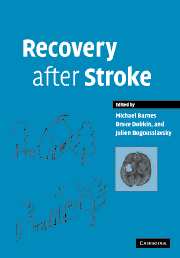Book contents
- Frontmatter
- Contents
- List of authors
- Preface
- 1 Stroke: background, epidemiology, etiology and avoiding recurrence
- 2 Principles of recovery after stroke
- 3 Regenerative ability in the central nervous system
- 4 Cerebral reorganization after sensorimotor stroke
- 5 Some personal lessons from imaging brain in recovery from stroke
- 6 Measurement in stroke: activity and quality of life
- 7 The impact of rehabilitation on stroke outcomes: what is the evidence?
- 8 Is early neurorehabilitation useful?
- 9 Community rehabilitation after stroke: is there no place like home?
- 10 Physical therapy
- 11 Abnormal movements after stroke
- 12 Spasticity and pain after stroke
- 13 Balance disorders and vertigo after stroke: assessment and rehabilitation
- 14 Management of dysphagia after stroke
- 15 Continence and stroke
- 16 Sex and relationships following stroke
- 17 Rehabilitation of visual disorders after stroke
- 18 Aphasia and dysarthria after stroke
- 19 Cognitive recovery after stroke
- 20 Stroke-related dementia
- 21 Depression and fatigue after stroke
- 22 Sleep disorders after stroke
- 23 Technology for recovery after stroke
- 24 Vocational rehabilitation
- 25 A patient's perspective
- Index
24 - Vocational rehabilitation
Published online by Cambridge University Press: 05 August 2016
- Frontmatter
- Contents
- List of authors
- Preface
- 1 Stroke: background, epidemiology, etiology and avoiding recurrence
- 2 Principles of recovery after stroke
- 3 Regenerative ability in the central nervous system
- 4 Cerebral reorganization after sensorimotor stroke
- 5 Some personal lessons from imaging brain in recovery from stroke
- 6 Measurement in stroke: activity and quality of life
- 7 The impact of rehabilitation on stroke outcomes: what is the evidence?
- 8 Is early neurorehabilitation useful?
- 9 Community rehabilitation after stroke: is there no place like home?
- 10 Physical therapy
- 11 Abnormal movements after stroke
- 12 Spasticity and pain after stroke
- 13 Balance disorders and vertigo after stroke: assessment and rehabilitation
- 14 Management of dysphagia after stroke
- 15 Continence and stroke
- 16 Sex and relationships following stroke
- 17 Rehabilitation of visual disorders after stroke
- 18 Aphasia and dysarthria after stroke
- 19 Cognitive recovery after stroke
- 20 Stroke-related dementia
- 21 Depression and fatigue after stroke
- 22 Sleep disorders after stroke
- 23 Technology for recovery after stroke
- 24 Vocational rehabilitation
- 25 A patient's perspective
- Index
Summary
Introduction
This chapter will discuss the principles, process, and practice of vocational rehabilitation in stroke. The definition of vocational rehabilitation is introduced because this has implication on the width of its endeavour.
The word vocation is often used to specify a profession or trade. But vocation also means choice of a life's career and a predisposition to a particular calling. Vocational rehabilitation is, therefore, more than just getting a person back to work. It is integrally woven into an attempt to bring back choices into a person's life. It often is the person's way back to his or her calling and life work. It is a route for a person with disability to gain back a right to give to society.
Vocational rehabilitation is defined as the attempt to maximize vocational potential and function. Rehabilitation is an approach to maximize physical, psychological, and social function of people with disability. There are three levels at which rehabilitation attempts to maximize function: impairment, activity (disability) and participation (handicap). Rehabilitation attempts to:
• alleviate impairment or actual loss of function
• improve activity that has been restricted by the impairment (i.e. it attempts to reduce disability)
• enable participation in a social role unfulfilled as a result of disability (i.e. it attempts to reduce handicap).
Vocational rehabilitation would need to address vocational needs at the three levels of impairment, activity, and participation. The discussion will draw on evidence from research on vocational rehabilitation in traumatic brain injury as there is little published on stroke. There is a reasonable amount of information available from similar, relevant research in traumatic brain injury. It could be argued that brain injury following stroke is different from brain injury following trauma. Comparatively, people with stroke might have more focal and less-diffuse frontotemporal injury, resulting in fewer cognitive and more motor sequelae. In addition, people with stroke are generally older, closer to retirement, and would, therefore, face different expectations surrounding their return to work at full capacity. However, the causative factors and sequelae are similar in any brain injury and vocational rehabilitation programs talk about “acquired brain injury” and include both groups in their programs. Consequently, evidence will be drawn from research on vocational rehabilitation in traumatic brain injury.
- Type
- Chapter
- Information
- Recovery after Stroke , pp. 623 - 636Publisher: Cambridge University PressPrint publication year: 2005
- 2
- Cited by



